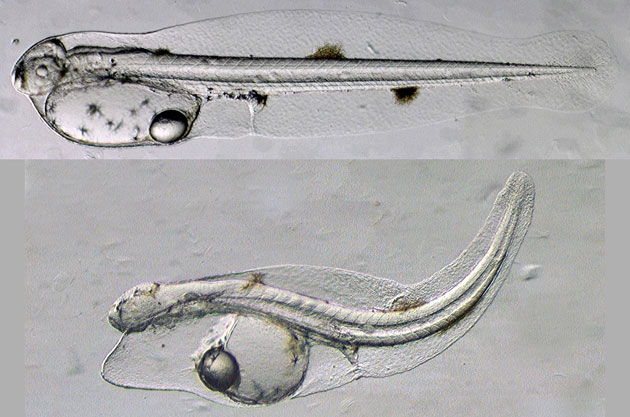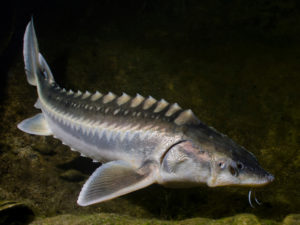When the Cosco Busan spilled oil into the Bay in 2007, the toxic toll on wildlife came as no surprise. More than six thousand birds died after the spill, with grebes, cormorants, and murres among the hardest hit. Within two years the herring population collapsed, too. The cause of death for the oil-coated birds seemed obvious. But the way the fish died wasn’t as clear.
Scientists suspected the fish had heart problems. After other oil spills, scientists had seen fish with barely beating hearts. But until about a month ago, no one knew why.
Now, seven years after the Busan spill, a group of scientists led by Barbara Block at the Hopkins Marine Station in Monterey have discovered the exact chemical pathway that makes oil such an insidious toxin -– and it has implications beyond fish health to humans as well.
“Two groups of scientists have been working together,” Block said. “Others showed evidence that oil causes the heart damage. Now we’ve shown how that oil exposure delays the timing of the on-off switch in the heart.”
At first, even “fingerprinting” the tanker oil as the cause of herring problems in the Bay was a huge challenge, said John Incardona, a toxicologist with the fisheries division of the National Oceanic and Atmospheric Administration. The Bay Area has lots of potential sources of oil in its water, like storm water runoff, local refineries, and automobile exhaust. The Richmond-San Rafael Bridge, with its base at Point San Quentin and the San Rafael Bay by the Marin Rod and Gun Club, looms over one of the biggest herring spawning sites.
Researchers at the Bodega Bay Laboratory had been studying herring populations in the area for years, though, and knew what to look for.
“We had sites that had healthy spawning within the last 10 years, so we could show that immediately after the oil spill there was a dramatic drop in herring numbers,” Incardona said.
Pacific herring are a sentinel species for oil spill damage. Once a year California’s largest population of herring come into San Francisco Bay to spawn. Arriving between November and March, the females make their way from open ocean to intertidal and shallow subtidal areas, where they expel super-sticky eggs on eelgrass, rocks, pier pilings and boat hulls. The Cosco Busan spilled the oil on November 7, just before the spawning season started.
After the San Francisco Bay spill, experts estimated that up to 29 percent of the next winter’s herring spawn was lost. The following year, 2009, the spawning biomass was the lowest on record and prompted the California Fish and Game Commission to close the commercial herring season. The numbers finally started to recover in 2010. But scientists aren’t sure the damage is over.
Clues to the heart maladies caused by oil have been floating around for a long time. In 2000, Gary Cherr and a team of researchers at the Bodega Bay Laboratory showed that creosote (an oil-based wood preservative) causes slower heart beats and swelling around the heart in herring eggs stuck on creosote-treated pier pilings.
Then, scientists who studied the salmon population after the 1989 Exxon Valdez spill in Prince William Sound found fish embryos there had slower heart rates, too – a condition called bradycardia. Many of the embryos also developed heart chambers with the wrong shape. Not surprisingly, these fish couldn’t swim as fast and became easier prey as they matured.
When the Deepwater Horizon pipeline broke – spewing sweet crude oil into prime spawning grounds for tuna – Block was studying tuna and their highly efficient use of oxygen. As questions cropped up about damages to fish in the Gulf of Mexico, she turned to the big fish for answers.
“Tuna are the Olympians of the sea,” Block said. “They can go from cruising speed to hunting in an instant, all under the stress of cold water.”
When the outside environment changes, the inside of a body has to compensate. If you’re a big fish and swimming fast, it takes a well-adapted circulatory system to keep going despite dramatic changes in temperature or pressure. Sort of like trying to run really fast up and down the Swiss Alps, without slacking your pace. More importantly, because of its athletic capabilities tuna turned out to be just the right fish to study.
A fish’s heart beat
This video, from John Incardona’s 2014 paper in the Proceedings of the National Academy of Sciences, compares the heartbeats of normal embryos and those exposed to oil in three different tuna species. The first fish shown is the normal embryo, the second is one exposed to oil. In each case, there is an observable arrhythmia.
With a special microscope, researchers watched the inner workings of individual heart cells in developing bluefin and yellowfin tuna. They compared normal young fish with those that were exposed to the breakdown products of oil – called polycyclic aromatic hydrocarbons (PAHs) – and discovered that these smaller chemical compounds block the pathway linking the electrical impulses in heart cells to muscle contractions. Without that link, called excitation-contraction coupling, cells literally can’t conduct a beat.
It takes a series of tightly orchestrated events to make a heart cell contract and relax with a regular rhythm. The process relies on the synchronized movement of sodium, calcium, and potassium ions through specific channels that lead in and out of a cell. If the timing of anything is off, the heart muscle cells – called cardiomyocytes – might miss a beat. In an embryo there aren’t many cells to begin with, so every cell needs to be in working order.
Before a heartbeat begins, sodium moves into a cell and starts an electrical current that acts like an “on” switch. When sodium channels are open, the switch turns “on” and that triggers the release of calcium from storehouses inside the cell. In turn, calcium trips the switch for the cell machinery that causes contractions.
But what contracts must also relax. It takes an outward flow of potassium ions to switch cells “off,” letting the muscle cell relax and get ready for the next round of action. When PAHs get into cardiac cells they clog those critical outward-bound potassium channels. The cell gets locked into a constant state of “on.” Without a way to relax and recover, the heart gets progressively slower.
The tuna’s need for speed means that it’s built with more of these potassium channels than most fish – and most other species. So when the scientists peered into the heart cells of young tuna, they found enough of the right channels to study. “If we’d looked at a mouse we might have missed this mechanism,” said Block.
PAHs also create another problem for heart cells. Block and her colleagues discovered that once the potassium channel is plugged and the cell is stuck “on,” the tide of calcium ions released inside the cells doesn’t rise as high as it should. The precise mechanism for this isn’t yet clear, but the end result is that lower calcium levels inside the cell lead to weaker contractions – a double whammy for a heart cell that’s already slowing down.
Next, Block wants to figure out precisely why calcium levels drop in these cardiac cells. She’d also like to find out what happens in other species – people, for instance. The same sorts of oil breakdown products that are toxic to fish in water also cause air pollution. Although there are well-known associations between human heart disease and air pollution, Block noted that no one is hunting – yet – for a similar mechanism.
“These potassium channels are well known in pharmacology,” Block said. “Every drug in America has to be tested to make sure it doesn’t affect these channels and cause heart attacks. If this oil was a drug – we’d throw it out.”
But funding for additional studies is scarce once damages have been assessed after a spill.
The $2.4 million settlement money for damage to the fish population has been targeted for eelgrass restoration, a plan that should also be a boon to other species.
Learning more about what happens to the fish in the long haul would help fisheries management, said Cherr. It might improve human health, too.





